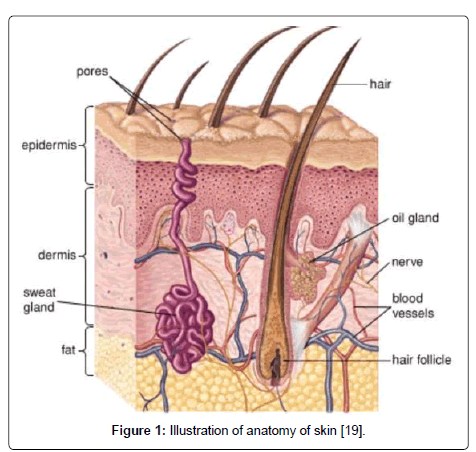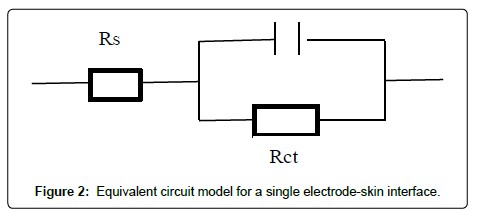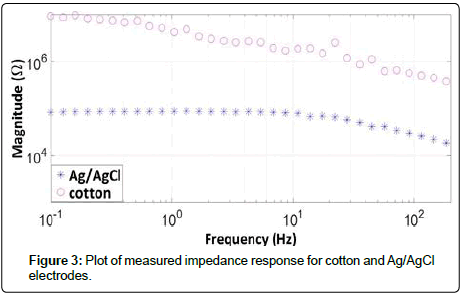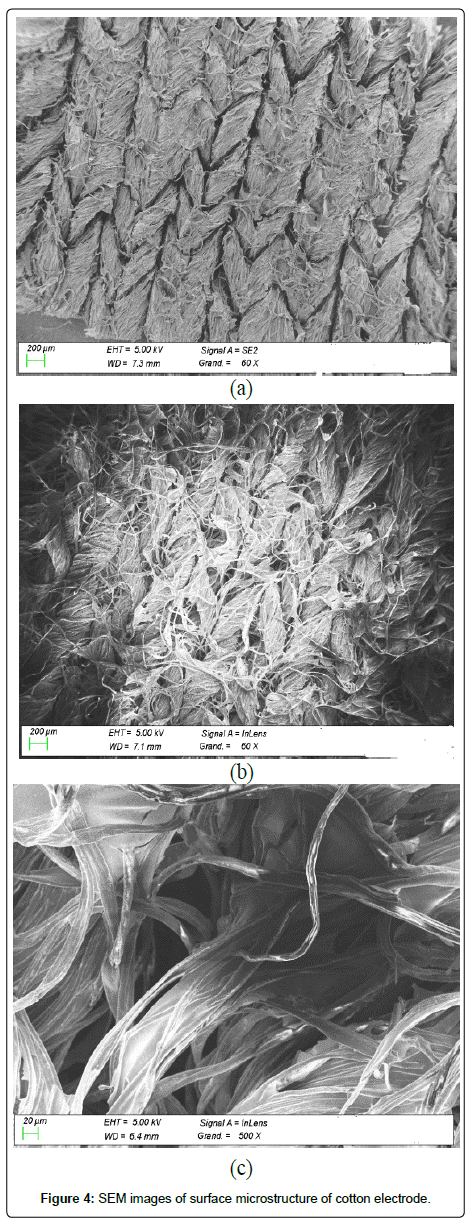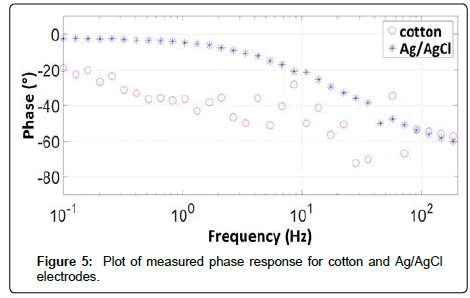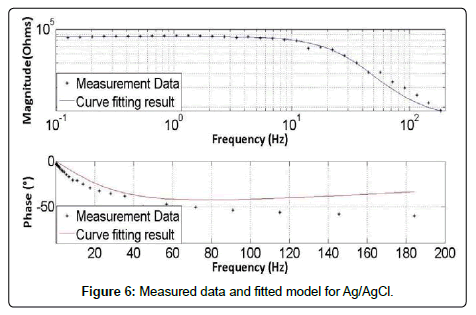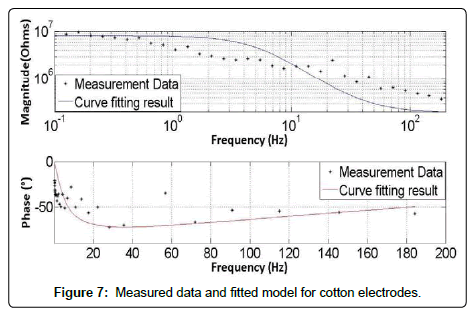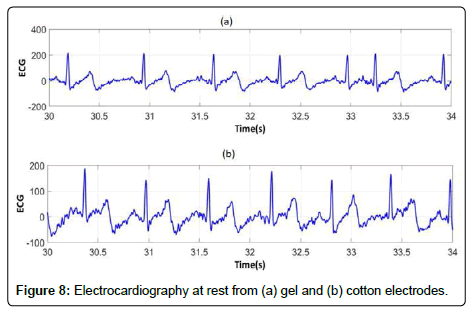Research Article, J Fashion Technol Textile Eng S Vol: 0 Issue: 5
Study on the Measurement Method of Skin Textile Electrodes Contact Impedance
Amale Ankhili1,2,3*, Xuyuan Tao1,2, Cédric Cochrane1,2, David Coulon3 and Vladan Koncar1,2
1ENSAIT/GEMTEX, 2 Allée Louis et Victor Champier, Roubaix, F-59100, France
2University of Lille, Cité Scientifique, Villeneuve d’Ascq, F-59650, France
3Health, Europarc de Pichaury, 1330 Rue Jean René Guillibert Gauthier de la Lauzière, F-13290 Aix-en-Provence, France
*Corresponding Author : Amale Ankhili
PhD Student, ENSAIT/GEMTEX, 2 Allée Louis et Victor Champier, Roubaix, F-59100, France
Tel: + 33 (0)3 20 25 86 94
E-mail: amale.ankhili@ensait.fr
Received: September 01, 2017 Accepted: October 04, 2018 Published: October 09, 2018
Citation: Ankhili A, Tao X, Cochrane C, Coulon D, Koncar V (2018) Study on the Measurement Method of Skin Textile Electrodes Contact Impedance. J Fashion Technol Textile Eng S5:004. doi:10.4172/2329-9568.S5-004
Abstract
Electrode-skin impedance is strongly influencing the quality of electrocardiograms (ECG) signals. Lower impedance results in stronger signals as well as less noise disturbance. In this study, we determine contact impedance between the skin and a flexible textile electrode based on a modified poly (3,4-ethylenedioxythiophene) :poly (styrenesulfonate) (PEDOT:PSS) coating, developed in our laboratory. Cotton knitted fabrics were used to test the measurement technique. For each measurement, a pair of same electrodes in terms of size was used. To obtain a better understanding of the obtained impedance results, the contact impedance was simulated by an electronic model and hence electrode circuit model components were calculated. In order to realize a comparative study, conventional medical electrodes silver/silver chlorides (Ag/ AgCl) were also assessed. The measurement technique can be applied to any other type of electrode in contact with a skin.
Keywords: Electrode-skin interface; Contact impedance; Silver/silver chloride electrode; Cotton textile electrode
Introduction
An electrocardiogram (ECG or EKG) is a record of the electrical activity of the heart over a period of time. It is done by electrodes attached to the outer surface of the skin and recorded by a device outside the body [1]. Each beat of the heart is triggered by an electrical impulse normally generated from special cells in the upper right chamber of the heart. An electrocardiogram (ECG) records these electrical signals as they travel through the heart. Doctors use an electrocardiogram to look for patterns among these heartbeats and rhythms to diagnose various heart conditions [2]. ECG is then used to measure the rate and regularity of heartbeats, the size and position of the chambers, the presence of any damage to the heart, and the effects of drugs or devices used to regulate the heart, such as an artificial pacemaker [3]. To obtain high-quality ECG signal, proper electrodes and compatible recording amplifiers are required [4,5]. Consequently, the contact impedance of textile electrodes in contact with a skin is an important parameter for an accurate ECG recording. It can introduce serious attenuation and distortion of ECG signals [6-9]. Inappropriate impedance may provoke an important noise in ECG signal similar to motion artifacts and therefore leads to misinterpretation of the signal with serious consequences.
The properties of electrode-skin interface are similar to the interface of an electrode in electrolyte solution. As shown in Figure 1, the skin consists of a high impedance stratum corneum (SC) layer with below tissue, the epidermis and dermis, having lots of conductive ions. Stratum corneum is the outermost layer of epidermis consisting of dead cells. Because of the difference concentration of conductive ions between SC layer and below tissue, ions are transmitted at the interface and consequently potential difference is occurred and a double layer structure is created. The thickness of stratum corneum of the same body site varies between individuals [10]. Subjects with dark skin have denser stratum corneum layers than subjects with fair skin. This leads to lower skin capacitances and higher impedances for dark-skinned subjects. However, the thickness of stratum corneum does not vary with age. Furthermore, there appears to be no gender differences [11]. Hair follicle density can vary between 40 to 70 cm-2, an increased hair follicle density decreases the resistance of skin [12]. Resistance of skin is also affected by blood circulation and the density of sweat glands which dependent on the body site. Consequently, electrical properties of skin can vary significantly between different subjects and body sites.
Figure 1: Illustration of anatomy of skin [19].
The equivalent circuit of the interface of electrode and skin has been studied by lots of researchers [13]. Swanson et al. [14] attempted to measure the skin-electrode impedance using a pair of Ag/AgCl electrodes with a diameter of 5cm. They described the interface between the skin and electrode as a parallel combination of a resistor and a capacitor in series with a second resistor. This model is known as a single time constant model. Moreover, Kaczmarek & Webster presented a more accurate model in which the interface electrodeskin is described as a double time constant model involving two time constants [15]. In this model, the skin electrode is considered as a non-linear second-order filter.
Wet (Ag/AgCl) and dry electrodes (textile flexible electrodes) are expected to have the same electrical model but the parameter values of capacitors and resistors could be significantly different. The capacitive components, corresponding to the electrode’s permittivity and skin layers demonstrate a dominant contribution of the skin to the skin–electrode contact impedance [16]. Wet electrodes are widely used for ECG monitoring, they consist of a metal snap, a silver/silver chloride (Ag/AgCl) coated sensors, a conductive hydrogel and an adhesive foam. The hydrogel offers a stable contact interface and also hydrates the skin and therefore decreases contact impedance. However, these electrodes cannot be used for longterm monitoring, because hydrogel can provoke skin irritation after prolonged contact with the skin. Furthermore, signals are degraded due to the gel drying out and the removal is also painful [17,18]. To avoid these drawbacks regarding wet electrodes, cotton electrodes have been fabricated, and their contact impedance have been calculated and discussed.
The main objective of this study is to determine contact impedance between the skin and a developed cotton textile electrodes based on a modified PEDOT: PSS coating. In order to assess the quality of the electrode contact, a medical Ag/AgCl has been used for comparison. This method is based on the response of electrodes to a small sinusoidal voltage. This measurement technique can be applied to any other type of flexible electrode in contact with the skin. The tests have been always made on the same person in the same ambient and body condition, meaning that human tissues have not been changed.
Material and Methods
Electrodes manufacturing
Poly (3,4ethylenedioxythiophene):poly(styrenesulfonate), also called PEDOT:PSS, type Clevios was purchased from Heraeus Conductive Polymers Division (Hanau, Germany). Cotton textile electrodes were manufactured by dip-coating with a chemically modified PEDOT:PSS solution and then dried at 100 °C for 20 min . After drying, electrodes were rinsed in distillated water to eliminate all remaining particles. The commercially available PEDOT:PSS solution had to be chemically modified in order to make it suitable for dip-coating process. The nature of the chemical modification cannot be revealed in this article because of confidentiality issues [19-21].
Commercial silver/silver chlorides (Ag/AgCl) (Ambu BlueSenor), medical electrodes were used to find out how our developed electrodes behave in term of contact impedance compared to medical electrodes.
Electrical characterization
For correct comparison, pair of same cotton electrodes in terms of size was used. It has been supposed that they have the same skin-electrode contact impedance. The size of each textile electrode is 3×2 cm2.
Electrodes were placed on forearm skin of the same subject because it has been reported that the impedance values differ from subject to subject and even within time for the same subject [22,23]. The first electrode was 4cm from the wrist and distance between two electrodes is 10cm. Plastic clamps were applied to maintain electrodes onto skin. The measurements were done without performing skin preparation at the electrodes sites and performed immediately after placing the electrodes
An Autolab potentiostat, equipped with FRA module (Metrohm B.V.), applying sinusoidal voltage of 10 mV was used for impedance measurements. It is equipped with reference (RE), worker (WE) and counter (CE) electrodes. A 2-electrode configuration was applied. Its setup was to connect CE and RE electrodes together in order to measure the voltage crossing WE and CE electrodes and the current flowing through them. Impedance was measured through frequencies from 0.1 Hz to 200 Hz. The impedance obtained reveals the impedance of electrode-skin interface and that of the tissue between the two electrodes.
ECG acquisition and analysis
The ECG data was acquired by using SHIELD-EKG-EMG chip from OLIMEX. The chip was configured on Arduino and data analysis was processed on Matlab (R2013a). The two electrodes to test were placed on the right forearm and the reference electrode is connected in the left forearm. The reference electrode was Ag/AgCl.
Results and Discussion
The equivalent circuit model for one electrode in contact with the skin is presented on Figure 2, where Rs is the total resistance of electrode, skin and test cables, Rct represents the charge transfer resistance of the electrode and Cdl represents the double layer capacitor between the electrode and skin. The equivalent impedance is expressed by (1). The magnitude and phase of impedance obtained by Autolab potentiostat are for two identical electrodes. Hence, (4) and (5) are respectively used to estimate the three components of the interface skin-electrode Rs, Rct and Cdl.
 (1)
(1)
 (2)
(2)
 (3)
(3)
 (4)
(4)
 (5)
(5)
Figure 3, shows measured impedance between electrode and skin when Ag/AgCl and cotton electrodes are used. For both cotton and Ag/AgCl, magnitude of measured impedance decreases with increasing frequency. At the same frequency, the magnitude of measured impedance of Ag/AgCl electrode is rather small than that of cotton electrode because of skin hydration effect of gel, which reduces the impedance of Stratum Corneum (SC) layer. At low frequencies, the magnitude of cotton impedance changes greatly compared to Ag/gCl. It decreased from 8.727 MΩ at 0.1Hz to 1.21 MΩ at 10 Hz. However for Ag/AgCl, it decreases from 83 kΩ at 0.1 Hz to 7.35 kΩ at 10 Hz. The highest value of cotton electrode magnitude is not only caused by the high value impedance of SC layer but also by the non-uniform distribution of PEDOT:PSS. This non-uniformity was studied by scanning electron microscope (SEM) images (Figure 4). The images show that the PEDOT:PSS is present in high quantities on the top of the electrode, while no PEDOT:PSS is found in some cross point of the knitted fabric.
The phase measured by cotton electrodes (Figure 5) shows small variation over frequency in comparison to Ag/AgCl. It decreases from -19° at 0.1 Hz to -57° at 200 Hz. However, for Ag/AgCl, it decreases from -2.5° at 0.1 Hz to -60° at 200 Hz. This result was expected because of the polarization of cotton electrodes.
The estimated values for the electrode circuit model components (Rs, Rct and Cdl) for Ag/AgCl and cotton electrodes are shown in Table 1. The electrode circuit model components values were estimated by developing a Matlab program based on the determination of the optimized best fit for impedance and phase model by minimizing the summed square of the error between measured and estimated data from measured values of impedance and phase. Figure 6 and Figure 7 show the measured and estimated curves of both magnitude and phase of cotton and Ag/AgCl electrodes.
| Ag/AgCl | Cotton based PEDOT:PSS | |
|---|---|---|
| Rs (Ω) | 8.1282×103 | 1.0000×105 |
| Rct (Ω) | 3.4798×104 | 4.0000×106 |
| Cdl (F) | 1.35×10-7 | 7.00×10-9 |
Table 1: Model parameter values.
From Table 1, the charge transfer resistance (Rct) of cotton electrode is far greater than that of Ag/AgCl. Good ECG signal requires low Rs and Rct values, because high Rs and Rct imply high contact impedance. The existence of gel in Ag/AgCl explains the lower value of Rs compared to that cotton electrode. The resistance of gel is much lower than sweat formed at the interface of skin-cotton electrode. Hence, gel overcomes the effect of highly resistant skin layer (stratum corneum).
Forcing a current i through the electrode-skin interface results in a change of potential difference at the interface which is called over-potential [6,11], in our case this over-potential is the additional voltage i×Rct. For an ideal non-polarizable electrode, the current can pass freely through the interface without any over-potential; it means that the electrochemical reactions (reduction/oxidation) can happen easily at the interface. Cotton electrode tends to be polarized electrode which explains its higher value of Rct (4.0000×106 Ω) compared to that of Ag/AgCl (3.4798×104 Ω) which has non-polarizable nature.
High Cdl value will imply better biological signal quality [24]. The measured Cdl value for cotton electrodes (7.00×10-9 F) is far lower than Ag/AgCl electrodes (1.35×10-7 F), it is due to the higher dielectric constant of gel compared to SC layer as expressed in (6).

Even though, cotton electrodes have higher contact impedance than Ag/AgCl, a decent ECG signal was obtained for medical analysis. Figure 8 shows that the P, Q waves and QRS complex corresponding to different phases of polarization and depolarization of cardiac cells were easily observed in the signals recorded using both cotton and Ag/AgCl electrodes. The ST segment was also observed, which is very important for myocardial ischemia and ventricular arrhythmias detection.
Conclusion
The contact impedance of textile electrodes in contact with the skin is an important parameter for an accurate ECG recording. High contact impedance is linked with low mobility of ions across the highly resistant stratum corneum layer of the skin, which could cause weak conductivity between the electrodes and the skin.
The quality of ECG signal depends on a low Rct and Rs values, and high Cdl value. In this study, results revealed that cotton electrodes exhibited much higher contact impedance in comparison to Ag/AgCl medical electrodes. However, good ECG signals were obtained for both electrodes, which explain that there is a limit of contact impedance when exceeded, ECG signals will not be obtained.
It is important to perform additional measurement of contact impedance of cotton electrodes, on different subjects, in order to study the reproducibility of material itself.
The chemical formulation developed for cotton, based on PEDOT:PSS is appropriate to various textile fabric, making flexible electrodes for long-term monitoring as compared to Ag/AgCl electrodes which are disposable and cause skin irritation.
Acknowledgement
Partial funding of this work was obtained from ANRT and @HEALTH Company.
References
- Hurst JW (1998) Naming of the Waves in the ECG, With a Brief Account of Their Genesis. Circulation. 98: 1937–1942.
- Walraven G (2011) Basic arrhythmias. (7th edtn), Pearson, London, UK.
- Braunwald E (1997) Heart Disease: A Textbook of Cardiovascular Medicine. (5th Edtn), WB. Saunders Co., Philadelphia, US.
- Neuman MR (1998) Biopotential amplifiers: Medical instrumentation: application and design.
- Yazicioglu RF, Hoof CV, Puers R (2008) Biopotential readout circuits for portable acquisition systems. Springer, Dordrecht.
- Neuman MR (2008) Biopotential Electrodes: Medical instrumentation, application and design. John Wiley & Sons, USA.
- Berson AS, Pipberger HV (1968) Skin-electrode impedance problems in electrocardiography. Am Heart J 76: 514-525.
- Dozio R, Baba A, Assambo C, Burke MJ (2007) Time based measurement of the impedance of the skin-electrode interface for dry electrode ecg recording. Conf Proc IEEE Eng Med Biol Soc 2007: 5001-5004.
- Assambo C, Burke MJ (2012) Low-Frequency Response and the Skin-Electrode Interface in dry electrode electrocardiography.
- Klingman AM (1984) Skin permeability: Dermatologic aspects of transdermal drug delivery. Am Heart J 108: 200–206.
- McAdams E (2006) “Bioelectrodes,” in Encyclopedia of Medical Devices and Instrumentation. (2nd Edtn), John Wiley & Sons, USA.
- Chien YW (1987) Development of transdermal drug delivery systems. Drug Dev Ind Pharm 13: 589–651.
- Geddes LA (1997) Historical evolution of circuit models for the electrode-electrolyte interface. Ann Biomed Eng 25: 1-14.
- Swanson DK, Webster JG (1974) A model for skin electrode impedance in: Biomedical Electrode Technology - Theory and Practice.
- Kaczmarek KA., Webster JG (1989) Voltage-current characteristics of the electrotactile skin-electrode interface; Proceedings of Annual International Conference of the IEEE Engineering in Medicine and Biology Society.
- Taji B, Shirmohammadi S, Groza V, Batkin I (2013) Impact of Skin– Electrode Interface on Electrocardiogram Measurements Using Conductive Textile Electrodes. IEEE Trans Instrum Meas 63: 1412–1422.
- Lopez-Gordo M, Sanchez-Morillo D, Valle F (2014) Dry EEG Electrodes. Sensors 14: 12847-12870.
- Meziane N, Webster JG, Attari M, Nimunkar AJ (2013) Dry electrodes for electrocardiography. Physiol Meas 34: R47-R69.
- http://kids.britannica.com/comptons/art-120217
- ASTM (1999) Standard D 257-99. Standard Test Methods for D-C Resistance or Conductance of Insulating Materials. ASTM International: West Conshohocken, PA, USA.
- IEC (1998) Protection of electronic devices from electrostatic phenomena-general requirements.
- Shigemitsu T, Nagata T, Matsumoto G, Tsukahara S (1980) Electrical properties of the carbon fibre electrode and its application. Med Biol Eng Comput 18: 359-362.
- De Luca CJ, Le Fever RS, Stulen FB (1979) Pasteless electrode for clinical use. Med Biol Eng Comput 17: 387-390.
- Grimnes S, Martinsen OG (2008) Bioimpedance and bioelectricity basics. (2nd Edtn), Elsevier, San Diego, USA.
 Spanish
Spanish  Chinese
Chinese  Russian
Russian  German
German  French
French  Japanese
Japanese  Portuguese
Portuguese  Hindi
Hindi 